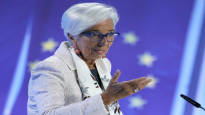The picture of the economy is grim, estimates the EU Commission. Germany, the largest euro economy, is in recession, but prices just continue to hurt. follows interest rate day in Frankfurt.
FRANKFURT Rarely have economic forecasters been as divided about the European Central Bank’s monetary policy as they are now. The 26 central bankers sitting on the European Central Bank’s Council are under a lot of pressure today when they decide on interest rates in the afternoon.
We live in the economy with a knife edge. The EU Commission just darkened its forecasts for the economy, because Germany is in recession and inflation is disrupting economic growth.
The situation can be summed up like this: what is good for one person is bad for another. For example, interest rates are already starting to be too high for Finns. Read more here.
In Germany, the largest euro country, on the other hand, the increase in the cost of loan money does not hurt in the same way, because the interest rates on German mortgages are fixed. Interest rates have been agreed with the bank for years to come.
On the other hand, for Germans, inflation is a bad thing, and taming it with the help of interest rates also gains popularity among the people.
Recently, economic observers have begun to be afraid again, the swear word of the economy, stagflation. It means an exceptional and difficult situation, where prices do rise rapidly, but demand, i.e. economic growth, weakens. This is the case in Germany right now.
However, stagflation is also associated with high unemployment. Germany doesn’t have that. On the contrary, the country has a labor shortage.
The ECB will announce its decision at 15:15, followed by the President Christine Lagarde answer the questions. The decision will be tough, because the council consisting of representatives of 20 different euro countries is likely to be very divided.
We listed the options that the ECB now has.
1. The interest rate will be raised slightly
An interest rate increase of a quarter of a percentage point is possible. Practically none of the experts who follow the ECB expect a bigger transfer than that.
It would not have a very big impact on the interest rates on Finnish debts, because the increase has already been priced into Euribor.
The fact that inflation in the euro area is still far from the ECB’s goal of two percent supports the increase in key interest rates. In August, prices still rose by 5.3 percent.
Analysts find it particularly worrying that the so-called base inflation has slowed down only slightly and is still over five percent. Core inflation has been washed away by the highly fluctuating food and energy prices. The core inflation figure shows that the rise in prices has already started to take on a life of its own.
2. Interest rates will remain at the current level
The central bank can also not touch interest rates. Due to high inflation, however, it should be able to credibly communicate that there is no room for a decrease in interest rates and that the current level will remain.
This would mean that the interest rate peak had been reached. Consequently, the most common Euribor reference rates for Finnish loans would not rise at least very much.
This option is supported by the fact that Europe is already in a slight recession.
3. Interest rates will be raised later
The third option is that the ECB leaves interest rates unchanged, but says it will return to the matter later. Thus, the interest rate peak would still be ahead.
In this option, the central bank would buy itself more time. It could expect more data on the economy during the fall. In this way, it also communicated that the fight against inflation continues.
Energy prices have recently risen. It could mean that inflation will prove persistent and perhaps even accelerate in September.
